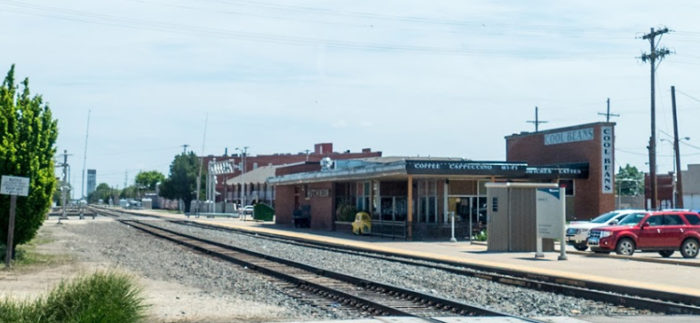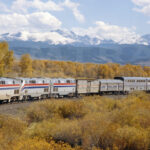More Effective Amtrak Advertising?
My late father-in-law was once asked what I did for a living. He replied, “Jim labors in the murky world of advertising.” He sure got that right.
Because everyone is a consumer of advertising, everyone feels competent to pass judgement on what is or is not effective advertising. It drives advertising people crazy and now here I am, about to do that very thing to Amtrak!
The fact is, however, more than a few of us have felt for some time that Amtrak should consider spending fewer of their advertising dollars promoting the Northeast Corridor in the very expensive east coast media. Some of those dollars could easily be diverted to promoting the long-distance trains in what would at first blush might seem to be in an unconventional way.
Instead of running generic ads on the joys of train travel, let’s see if we can actually increase ridership on a specific long-distance route just by raising awareness of Amtrak in one small community.

Using the town of Hutchinson, Kansas, with a population about 41,000, as an example, here’s the basic idea: the Southwest Chief stops in Hutchinson, but in the wee hours: the eastbound train at 2:20 a.m., the westbound train an hour later. The challenge is to remind those people that Amtrak is affordable public transportation and it passes right through their town!
So we run a schedule of small ads—just 2 columns wide by 6 inches deep—in their daily newspaper, the Hutchinson News. The ads would appear once a week for three or four months at a cost of about $175 each time.
The brief copy would simply remind people that the Chief goes through Hutchinson twice every day—one train east to Chicago; the other west to Los Angeles—and it would include the most basic information about which cities and towns are on the route and what it costs to get there.
Then, after several months, we would compare ridership for that period with the ridership numbers for the same time a year ago. I’m betting the results would show an increase in the number of passengers boarding the Chief at Hutchinson–evidence that a modest little ad campaign can actually increase ridership.
Whaddaya think? An idea worth pursuing?





Actually, during Amtrak’s initial years, 1971-1980, it enjoyed a very enthusiastic, knowledgeable marketing team and a competent ad agency that understood the KISS concept: provide train name, some destinations, departure times, and sample fares. Of course, service frequency and schedule convenience are key towards supporting such an ad campaign, which I identified when providing NARP’s Tony Haswell such a Midwest Corridor model between Chicago-Memphis in 1972.
In those years, Amtrak appreciated the concept of a Brand Manager by instituting Route Marketing Operations Directors who enjoyed far more freedom to trial and test than today’s Route Manager/Train Manager role. For example, in 1972, we witnessed the first run thru service between Milwaukee-Chicago-St. Louis, supported by solid advertising.
Unfortunately, as corporate attention was diverted to the NEC, brand marketing and supportive advertising was relegated to the back-burner west of the Potomac, aside from the hands-on approach by the progressive states of California, Washington, Oregon, North Carolina, and now, Virginia. What has Amtrak marketing contemplated these days about run thru operations between the Midwest Corridors to maximize asset utilization and eliminate transfers in Chicago? (To what extent would this be feasible re only two run thru tracks at CUS, signaling and T&E districts?)
Interestingly, we still find how befuddled marketing has become even in the NEC, as a good brand manager would appreciate the opportunity of the numerous multi-market segments not served by the “Acela” by offering first class on the “Northeast Regionals.” As well, although NARP’s visionary, Tony Haswell, knew how to take on and deflect Greyhound’s attacks (“have you ever seen a Greyhound snowplow on I-95..?), where is Amtrak today to aggressively advertise against the curbside bus firms on the NEC, Midwest, and West Coast? How can the attitude continue to be to observe the peeling away of the college and elderly traffic respond defensively it is not Amtrak’s market? Concomitantly, luxury bus lines, e.g., Limoliner, are attacking from the top of the market.
Sometimes we all think too big and make the solution impossible. We all expected ET to phone home and now it looks like we found ET as germs on the outside of the Space Station that are not of this earth. I think the local small market advertising is a great idea especially in areas with no cost effective alternatives. I think RPA should try and get some celeb sponsors/fans as well…..couldnt hurt.
This is a good idea. In the mid-1980s, the Minnesota Association of Railroad Passengers placed with its own funds a quarter page display ad in the weekly “shopper” newspaper serving Devil’s Lake (and Ramsey County), North Dakota for four weekly insertions. The paper’s staff helped us with the layout at no extra charge.
We timed the ad for the Spring “window” when seats, and more importantly, sleeping car rooms, were widely available. (It makes no sense to advertise into a peak period.)
The ad had no fancy art or clever slogans. It featured hard information on the Empire Builder, where it went, when it called at Devil’s lake, where it connected to other trains, the services it offered (diner, lounge, sleepers), and a few sample fares. We included only the local phone number of the Devil’s Lake depot. There was no internet then.
We used the local number rather than the 800 number because the local agent was willing to track sales and calls for us.
The return, measured in dollars of sales, on our modest outlay for the ad, was 1,700%.
The agent had people who lived there who said they weren’t aware of the Empire Builder, or what it did. He had walk-in traffic that had never occurred before.
The effect of the ad tapered off about three weeks after the last insertion.
Amtrak ignored the results of our experiment.
Thanks for this. I was not aware of the MARP effort, but it does support my gut feeling that a simple campaign, sustained through the normally slow periods, would more than pay for itself. Great minds, eh?
I would vote for Fargo,ND on Empire Builder route. Lord knows the Forum Newspaper could use the revenue,as could the Spectrum at NDSU, as well as Minnesota State. The population is 150,000 and woefully ignorant of passenger trains. EB comes thru about the same time as Hutchinson, KS. People don’t like the time, but will get-up at 4:30 am to catch an early morning flight. Lots of opportunity to enlighten old and young.
Alas, late running is enough of a thing on the long-distance routes that the one train a day is at best a poor substitute for the intercity bus, even if you can find an intercity bus that makes local stops these days. For instance, it’s got to be disheartening to passengers in South Bend or Sandusky, who often have to wait a long time while Norfolk Southern’s artificial intelligence continues to figure out that no, you shouldn’t run a land barge into Elkhart, ahead of Amtrak, in the face of seven per diem trains going west.
That idea sounds reasonable to me. But has no one at Amtrak thought of such a radical plan?
So, how bureaucratic would it be to implement such a decision at Amtrak? Is a chart available from Amtrak that shows the reporting relationships in the Amtrak organization (perhaps including names and contact information for all Amtrak executives)?
For example is there a marketing director for each long distance route responsible for increasing ridership and revenue on a specific train?
Would that person, in turn, report to a GENERAL marketing director, or an advertising director?
If a Southwest Chief marketing director knows what he wants his advertising to say and accomplish, knows he wants to buy a particular newspaper with X number of column inches for Y number of months, does some sort of national marketing director or advertising manager have the authority to countermand what the Southwest guy wants?
Or is there ANYONE in the chain of command at Amtrak charged with increasing the performance of a given LD route who also has the authority to buy the advertising and create the promotions necessary to attain such increased performance? Is Amtrak run like a business that needs to increase sales and share of market?
All good questions for which I have no answer. Frankly, I’d love to see RPA (fka NARP) undertake this project ourselves, purchasing space in five or six newspapers published in towns along one of the long-distance routes. It would be simple enough to do and would not cost a great deal of money.